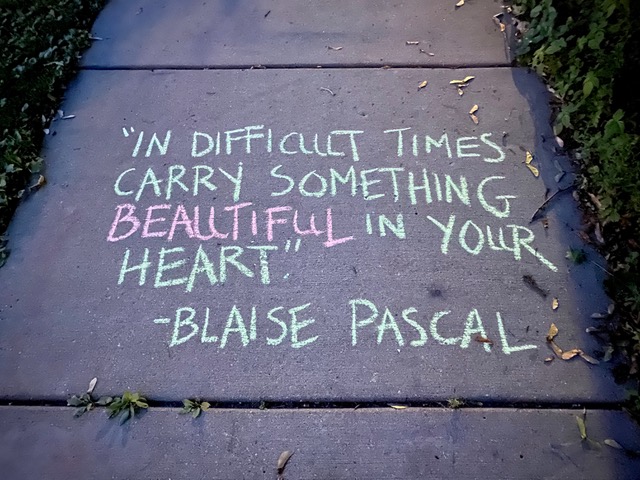
COVID-19: Linden Hills Neighbors’ Stories
This LiNK series features different Linden Hills residents as they share how they are experiencing COVID-19. If you have a story to share, please email carol@lindenhills.org.
Quarantine Quotes of the ( Almost Every ) Day: A Profile of Jenny Schroedel – By Judy Hornbacher, LHiNC Board Member
Our goal in writing these profiles of Linden Hills residents is to introduce us all to our neighbors, the interesting places they come from, their reasons for being here and a bit about them as individuals, particularly as we go through these trying times.
Those goals have been more than met in my conversation with Jenny Schroedel, a relatively new resident in the neighborhood. (Full disclosure, I knew Jenny when she was a young girl in Edina but have not seen her for 20 plus years.)
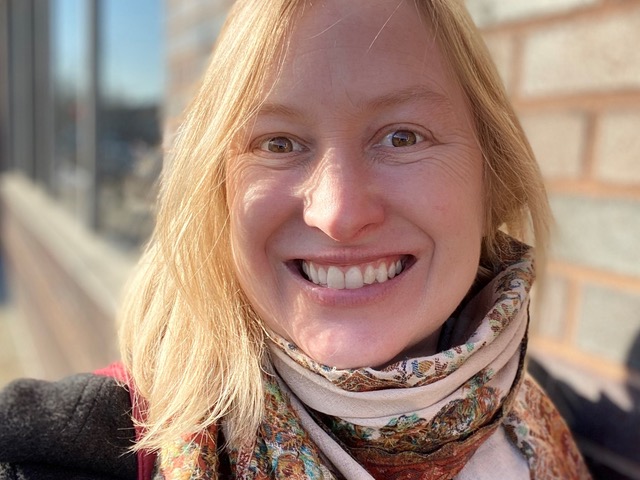
Jenny Schroedel, her husband and two daughters lived in Hawaii for 10 years. John is an Eastern Orthodox priest, the girls were in school and Jenny found her own vocation as a Hospice Chaplain and then full time Grief Counselor. She and her colleagues had just finished rehabbing an old shack into a full time Grief Center when Kona started experiencing earthquakes, there were evacuations, and finally, the volcano erupted after 99 days of volcanic activity. The Center was destroyed. John was experiencing trouble breathing, and they had to leave the island.
The family moved to Minneapolis where her husband John continues his work as an Eastern Orthodox priest. Eighteen-year-old daughter Anna Pepper just graduated from high school in Hawaii (Of course she was not actually in Hawaii…she was covered with leis by her family here and virtually feted with good wishes from there, like all the kids in the class of 2020.)…and is just now starting college at Notre Dame. Jenny is very happy to be back. Her roots are here, her great, great, great grandfather is buried in Lakewood Cemetery as is her brother and other relatives. Her parents are here. She rode the trolley when she was a little girl.
Jenny, a force of positivity and joy, is working for Presbyterian Homes and Services in hospice care and grief counselling. Currently she is doing Grief Groups full time from her home on Zoom. She actually enjoys the Zoom groups because she finds them to be more intimate when people are in their own homes.
As part of her work, she started something called The Quarantine Quote of the ( Almost Every ) Day, in which she blogs about the human experience of grief and finds extraordinary references to this essential human emotion. She also writes the Quote of the Day on the sidewalk in front of her house. And when people stop by to read the quote, her daughter Natalie exclaims, “Mom, you’ve got customers!” Her quotes have allowed her to meet what she considers to be the very “thoughtful, curious people” in Linden Hills.
Why did she start the Quote of the (Almost Every) Day? To remind us that grief is something we all experience at every stage of life. Not just seniors, but adult children with aging parents, teenagers over having lost their senior year, the personal ambiguity of lockdown, of job loss, the grief of possibly dying alone, the grief of injustice and civil unrest. This is her work and she generously shares her insights with us.
And by the way, not all is solemn. Sometimes all the Schroedels dress up like fruit.
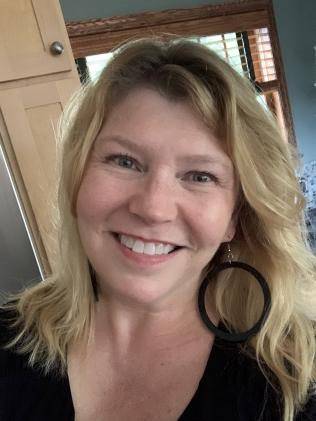
The Teacher Lives in a Zoom Room
By Carol Clemens, LiNK Editor
Linden Hills resident Kris Westberg has taught 4th grade at a local independent school for 16 years. In mid-March of 2020, life for Kris as a teacher, her students and their parents entered the uncharted territory called “remote teaching and learning”.
What happened when the COVID-19 pandemic forced closure of schools on such short notice?
Our school was heading into a two-week spring break in mid-March. In anticipation of the COVID-19 school closing, the school went into action. Before kids even left for spring break, teachers assembled take home bags with textbooks, work packets, notebooks, writing tools, etc. We packed up our manuals, folders, books, and anything we thought we might need. We initially planned for about three weeks of remote teaching and learning little did we know it would end up being eight weeks.
Was your school prepared for remote teaching and learning before this happened?
There were some communications between administration, families and staff letting us know that remote teaching and learning was a possibility.
When spring break was over, students used the first week to get organized for remote learning and to work on “choice activities” that we put together to provide us teachers time to get up to speed with technology and remote teaching.
Were you teaching from your home?
I taught students from my basement while my husband set up his virtual office on our main level. Setting up my “classroom” was the easiest part of the transition, I had all my reference books readily available, as well as record keeping folders and office supplies. I discovered that the height of our basement bar and barstools was perfect for conducting Zoom meetings!
What did you have to do to get set-up for the virtual classroom?
To prepare for teaching in a virtual environment, the four teachers at my grade level decided to divide and conquer our academic subject areas. Each of us was responsible for preparing lessons for one or two subjects, but for all 80 students. I was responsible for teaching reading and social studies. In the regular classroom, each of us taught all academic subjects to our own classroom of 20 students. I think this was a very smart decision on our part. I could not imagine having to prepare remote lessons in all subject areas for my students.
Once the COVID reality set in for you and your students how did you manage the new challenge of communicating, keeping in touch with parents and the emotional toll of quarantine on everyone including yourself?
The school set up a remote teaching and learning-landing page. The landing page had links to each teacher’s weekly remote teaching and learning plan. Parents and students would check the plan each day to see what work was assigned, when to tune into a Zoom meeting, and get links to video lessons. We sent weekly emails to keep parents up to date.
Over the course of eight weeks I fielded more emails from parents and students than I probably would in a year. I think the emotional toll was high for everyone. Our school counselor was kept busy meeting with parents and students when requested.
Unequivocally I missed seeing my students in person most. I missed interacting with my team of teachers. I missed my classroom. No matter how many Zoom meetings I had; they were not adequate substitutes for in-person interactions.
In my 20 years of teaching, I don’t think I’ve done anything more challenging than remote teaching and learning! In addition, I retired at the end of this year. It is certainly not how I imagined ending my teaching career. So emotionally, this was a very difficult time for me.
How did working-from-home parents balance their roles of employee, parent and teachers assistant?
Some families were better able to provide 1:1 support to their child than other families. Some kids had to really step up to the plate and be more responsible for themselves. Overall, I was very impressed with both the parent support as well as the independence kids showed.
Did your students have their own digital equipment or did they have to share with siblings and parents?
The school did make arrangements for families who requested a laptop or iPad. Obviously, this helped to reduce the amount of sharing between devices.
How did that affect their experience?
For students in my class, family members sharing devices didn’t seem to be much of an issue. Most of the tech challenges I observed seemed to come from having too many devices sharing the home Internet.
Were you involved in video 1:1 tutoring and conferencing?
Teaching our 4th grade students was split between synchronous and asynchronous teaching and learning transmissions. With synchronous teaching and learning, I often had 20-minute 1:1 sessions via Zoom with kids. Kids had the opportunity to request a meeting or I may have requested the meeting. Sometimes kids just wanted to chat, other times we talked about academics or technology, and other times it was a check in just to see how things were going. My 1:1 time with students was one of my favorite times. In addition to 1:1 meetings, I held small group and whole group Zoom meetings for synchronous teaching and learning.
What were the most difficult aspects of remote teaching and learning?
With teaching in the classroom, I was rarely in front of a screen. With remote teaching and learning I was in front of a screen for eight hours a day. That was the hardest part. Once school was over, I couldn’t use Zoom for two weeks. Another emotional part was just not seeing my students in person. I missed their spontaneous hugs, jokes, stories, and smiles. I also missed watching my students support each other. I know that was one of the hardest parts for my students as well. We all missed each other!
How did you manage to keep the students engaged with each other?
Twice a week we had whole class Zoom meetings – one meeting to start off the week, another one to end the week. I tried to run the meetings like I would in the classroom to help provide a sense of normality. In these meetings students would greet each other, we would have sharing time, then play a game. A whole class meeting typically lasted about 30 minutes. Academically, I love to have kids share their work with each other. The easiest way I found to do that remotely was with an app called FlipGrid. Students would take a video of themselves presenting their work or ideas then other kids would create a video response to their classmates. Also, kids often would set up their own Zoom meetings with each other or use Google hangout or chat.
What did you and your students enjoy most? What was most difficult?
As we approached the end of the year, I asked my students these same questions. Some common things my students enjoyed were: having more family time, sleeping in, staying in their pajamas for school, being in charge of their daily schedule, and video chats with teachers and classmates. Some things they often found most difficult were: getting immediate help when they needed it, time management (not getting distracted with video games), and being away from their friends and teachers.
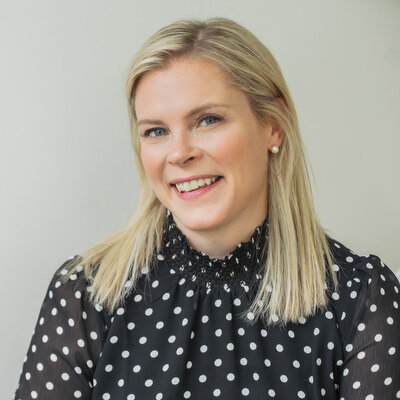
COVID-19 Hit Home for a Linden Hills Physician
By Linda Picone, LHiNC Board Member
Krista Olsen, MD, has had to figure out how to balance work and family life in a demanding, difficult new way during the COVID-19 pandemic and state stay-at-home orders. Krista is a mom, OB/GYN-physician, and life-coach. She regularly sees clinic patients and works at a hospital; and she was infected with COVID-19 and recovered.
Dr. Olsen started feeling ill in mid-March after she and her husband R.J. Kern came home from a vacation to a sick babysitter and rosy cheeked, feverish four and five-year-old children.
Two days later, Dr. Olsen kept waking up in the middle of the night. “I felt like I’d been hit by a truck,” she says. The next morning, her temperature was 102.6F. “I tried to get tested, but even though I was a health care provider, they wouldn’t test me,” she says. “There weren’t enough tests. I was sick for about three days with fever and body aches, and then the fever went away. On day five of being sick, I completely lost my sense of taste and smell. That next morning, I was able to get in and get a test.”
Her test came back positive for COVID-19.
When her results came back, her husband and children were considered “people under investigation” and were quarantined for another 14 days – a total of 21 days confined to the house. She feels fairly confident that her children and husband also had COVID-19 but, fortunately, none of them became seriously ill.
When she was confirmed as positive, Dr. Olsen says, the CDC and Minnesota Department of Health guidelines were that anyone who had – or suspected they had – COVID-19 needed to stay quarantined until seven days after their first symptoms and/or three days after symptoms resolved. The CDC ha since revised its guidelines and now recommends quarantine for fourteen days after first symptoms of COVID19.
Being away from the clinic and the hospital for 16 days did not mean that Dr. Olsen wasn’t working, however. She had some leadership and social media activities for her clinic group that she could do from home, and she began doing virtual office visits with patients.
In fact, Dr. Olsen was a leader in her clinic group, figuring out how to do virtual visits, almost overnight. She is certified as a life coach and has been working with women all over the country for more than a year, using Zoom to connect with them. She was able to put that experience to use in helping set up safe Zoom visits for patients. Some patients still need to be seen in the clinic, of course, and babies aren’t delivered “virtually,” but Dr. Olsen says both patients and physicians are likely to want virtual options as part of medical care in the future.
The first weeks after becoming ill and after the state stay-at-home order, Dr. Olsen and Kern both worked from home and cared for their children, whose daycare had closed. “We kept trying to get really creative about activities for them, to keep them stimulated.
Although Dr. Olsen is back at work now, and her children are in a daycare that provides for health care workers, she has made a number of changes. Besides doing virtual visits as part of her clinic work, she is very careful about what she does between work and home. “We don’t know that the kids had COVID-19 or, even if they did, that their antibodies will protect them,” she says. “And I’m still working in a hospital and then coming home.” She changes clothes when she leaves the hospital, and leaves her shoes outside the door when she gets home, to minimize any possible transfer of the virus.
Having had and recovered from COVID-19 has given Dr. Olsen a different perspective on the disease, she says, especially since she is working as a life coach with women around the country, many of whom are anxious and frightened; “They say it brings them a sense of peace to know someone who’s come out of it.”
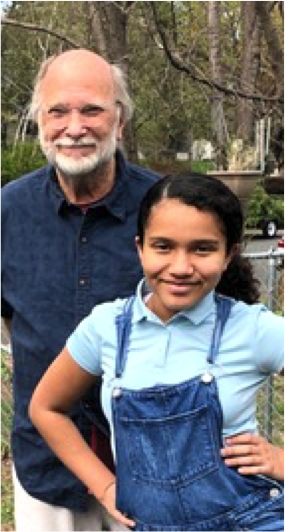
Learning to live alone (while sheltering in place) isn’t easy for an extrovert – By Linda Picone – May 11, 2020
Living alone for almost the first time in half a century has not been easy for Peter Albrecht, 75, a retired Hennepin District Court judge and an outgoing man who enjoys the company of other people even more than most. It’s an adjustment for anyone, but adjusting to solo life during this time of pandemic and a state stay-at-home order removes options like throwing yourself into group activities or relying on the company of good friends. “I lived alone during college and law school, but I haven’t lived alone for a long time,” says Albrecht. “And I don’t like it.”
Albrecht, like many people living alone in Linden Hills—particularly older people who are more at risk for becoming seriously ill if they contract COVID-19—is figuring out how to fill his days with meaningful and useful activities and how to connect with others when the usual ways to do that are not available.
Although Albrecht has lived in Linden Hills for more than a decade, he moved into his Sheridan Avenue townhouse in November, after separating from his wife. He thought there might not be much to do in the smaller space but, luckily, he says, he’s discovered a number of home projects that can help occupy his time—and give him a sense of both purpose and satisfaction.
There are rooms to be painted, shelves to be built, racks to be constructed for his 20 or so guitars and banjos. Albrecht’s father passed on a love of making and fixing things and Albrecht says, “I’m never happier than when I’m sitting at my workbench.”
He also plans to be more deliberate in studying music while staying at home. While he’s enjoyed playing music for decades, he’s decided that now would be a good time to hone his skills and advance. He’s found that he can take lessons online, and says he plans to get serious about taking some. And then, with typical humor, he tells the story about three frogs on a lily pad: One of the frogs decides to jump off. How many are left on the lily pad? “Three,” he says. “One decided to jump off; it doesn’t mean it actually jumped.”
For six weeks, starting from the about the time schools got out for spring break—a break that now will last through the end of the school year—Albrecht had his 12-year-old granddaughter, Elena, staying with him, giving him the opportunity to home-school with her. Elena’s mother, Albrecht’s daughter, suggested the arrangement as a help to her, but Albrecht says, “I think it was more to keep me mentally safe.” Elena recently went home to her mother—they had never been apart for more than a day or so and “they missed each other terribly,” he says. He also claims that he was not particularly good at making sure Elena was getting the most out of home-schooling. “I just said, ‘Have you done your homework?’ and then took her word for it.”
On the day Elena went home to her mother, Albrecht says it hit him how much he was going to miss her; her presence in his home was a constant. “I took for granted that she was there.” He can’t fill the hole her absence has created, but he is trying to engage with other people as best he can.
“I am sort of outgoing,” he says (a definite understatement). “When I go to and from the lake on walks, or when I walk around the neighborhood, I talk to people and introduce myself to people I don’t know.”
If you encounter him on a walk or when he passes by as you are outside in your yard, be sure to stop and enjoy a bit of conversation and laughter with him. From a safe distance, of course.
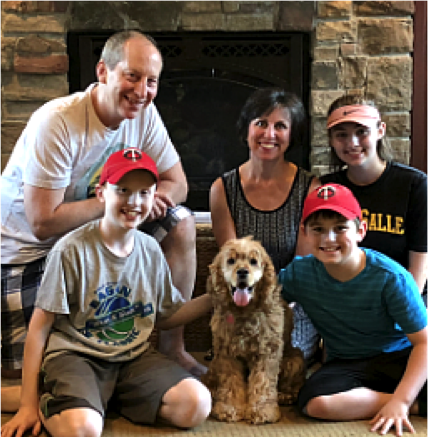
Meet The Sellners – By Carol Clemens, LHiNC E-news Editor
May 4, 2020
The Sellner family began their personal COVID-19 story by being forced to cut short a planned six-week European adventure. Emma (16), a De LaSalle “Islander,” left February 15 for an exchange student visit to Valencia, Spain. Two days later, Carrie, Tim and their boys Franklin (14) and Phillip (10) were on their way to a trip of a lifetime – the itinerary: travel through Bavaria, The Great Dolomites, Tuscany, Florence and then spend time in Spain with Emma and her host family before going home.
It was after dinner in Vernazza, a small coastal town in Italy, accessible only by railroad when the excitement began. The COVID-19 situation in Italy was changing quickly – Tim got a message on his phone at 10:00 p.m. that Italy was closing the borders the next morning. They didn’t even know if they could get a train out at that hour.
They packed, ran to the train station and made the 11:30 p.m. train, got their car out of a garage 25 miles away and proceeded to drive three hours in the middle of the night towards Florence (hoping the government had not yet set up roadblocks). They made their connection and caught one of the last planes to Barcelona. It was soon clear that Spain was also at the cusp of the COVID-19 impact and they had to leave without stopping to see Emma in Valencia.
The family caught the last KLM flight out of Barcelona and returned home to Linden Hills March 13, four weeks after they left. Now the nervousness was acute, they still had to get Emma home. Thankfully things went as planned and she got on a flight on March 15 to join the rest of the family in a three week mandatory “traveler” quarantine.
Home again post-quarantine reflections
Carrie: We have homeschooled our children for several years, however this is quite different; while we are well accustomed to learning together at home, activities and field trips to museums, parks and theatres have been cancelled. And, then there are piano lessons on Facetime!
We have welcomed relaxed family meals with more time for conversation. However, some days simply feel scattered and unproductive. On the other hand, it has been refreshing to slow down to sleep more, read more and embrace family time.
Phillip: I miss watching the Twins, but mostly I miss being able to play baseball. I’m working on baseball skills with my dad and brother in our backyard. I’ve always home-schooled, we’re doing a family art class and painting. I really like art.
Koby: Canine people walker. All of the Sellners have mentioned Koby as a primary motivator for one of their daily exercise routines.
Franklin: I bike and play basketball in the driveway, but I miss sports – especially baseball and hanging out with friends. It was sad when my grandpa had a heart attack and we couldn’t go visit him. I think it is a great time to spend quality family time doing activities like taking a walk, board games, being outside & just having great conversations with the family.
Emma: Biggest challenge I have personally faced is not being able to see my friends and not having my normal structure and routine. Since being in quarantine the smallest things have brought a smile to my face. Whether it’s having a meal with my family or dropping a small gift off at a friend’s house, I appreciate the little things so much more.
I have been FaceTiming with my friends which is better than nothing but still not the same. I have also spent time with friends (six feet apart) by the lakes.
Tim: The unexpected gift that COVID-19 has given us is extended meal times, particularly with our 16-year-old daughter Emma. “Normal life” dictated me coaching the younger boys basketball or baseball teams generally 4 to 6 nights a week. High school life was filled with school, study, friends and extracurricular activities. Dinner together? Extended time at the dinner table – Not possible!
We have re-discovered how wonderful it is to linger for an extra hour or 90 minutes after the meal is over and just let the conversation flow into fun, frivolity and fruitful important discussions. I feel like we have our daughter back before high school and college takes her away again. A great blessing.
Feelings regarding COVID-19: emotionally I feel a mixed bag. A little bit of survivor’s syndrome since we don’t know of anyone personally who has died or become really sick with the virus. We normally home school our boys and I often work from home so day-to-day life has not changed too much. We certainly miss baseball but It’s actually been really nice to work on hitting and pitching with my boys one on one rather than in a large group. We have set up a large screen in a tree that we hit into which has been a blast.
Final thoughts from Carrie: Somewhere I read this…”Let’s not say we’re all in the same boat.” We are all in the same storm, but our boats differ greatly.
Although in our daily life we feel the inconvenience of staying home and not spending time with family and friends, we know that many people feel the impact of this crisis in vastly different ways. Our family is using this to reflect on as we find opportunities to offer help outside of our home and neighborhood.

